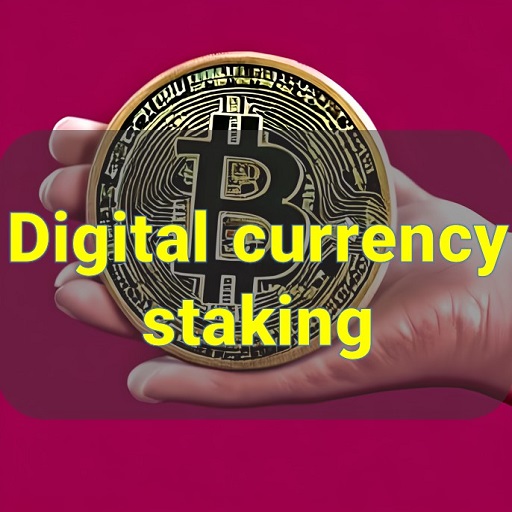Digital currency staking is a process where users hold and lock their cryptocurrencies in a wallet or on a platform to support the operations of a blockchain network. By staking their tokens, users contribute to the network’s security, consensus mechanism, and transaction validation. In return for staking, users receive rewards in the form of additional cryptocurrency tokens.
Staking typically involves a Proof-of-Stake (PoS) or a variation of it consensus algorithm. Unlike Proof-of-Work (PoW) used by cryptocurrencies like Bitcoin, where miners solve complex mathematical puzzles to validate transactions and secure the network, PoS relies on participants staking their tokens as collateral to create new blocks and validate transactions.
Here’s a general overview of how digital currency staking works:
Choosing a suitable cryptocurrency
Not all cryptocurrencies support staking. You need to select a cryptocurrency that utilizes a PoS or PoS-based consensus mechanism.
Setting up a wallet or using a staking platform
To stake your digital currency, you’ll need to have a compatible wallet or use a staking platform provided by the cryptocurrency project. Some cryptocurrencies have their own official wallets, while others may rely on third-party wallets or platforms.
Acquiring the cryptocurrency
If you don’t already have the cryptocurrency you wish to stake, you’ll need to acquire it through a cryptocurrency exchange or other means.
Transferring the cryptocurrency to a staking wallet or platform
Once you have the cryptocurrency, you’ll need to transfer it to a wallet or platform that supports staking. This wallet or platform will lock your tokens for a specified period during which they’ll be used for network operations.
Participating in the staking process
After your tokens are staked, they contribute to the consensus mechanism of the blockchain network. The specific requirements and rules vary depending on the cryptocurrency. Some networks may require you to actively participate in validating transactions or maintaining a certain level of network uptime.
Earning staking rewards
As a reward for staking, you’ll receive additional cryptocurrency tokens. The rewards are usually distributed proportionally to the number of tokens you’ve staked and the duration of your staking participation.
It’s important to note that staking involves locking up your tokens for a specific period, and during this time, they may not be easily accessible for trading or other purposes. The staking rewards and the risks associated with staking, such as slashing penalties for malicious behavior or network instability, depend on the specific cryptocurrency and its consensus mechanism.
Before engaging in staking, it’s recommended to research and understand the cryptocurrency project, its staking requirements, potential risks, and rewards.
How is the staking process?
The staking process can vary slightly depending on the specific cryptocurrency and the staking platform or wallet you choose to use. However, here’s a general overview of the staking process:
Select a suitable cryptocurrency
Choose a cryptocurrency that supports staking and aligns with your investment goals and risk tolerance. Research the project, its technology, team, and future plans.
Set up a wallet or choose a staking platform
Determine whether you want to stake your tokens using a wallet or a staking platform. Some cryptocurrencies have their official wallets that support staking, while others may require you to use third-party wallets or specialized staking platforms.
Acquire the cryptocurrency
Obtain the cryptocurrency you want to stake through a cryptocurrency exchange or other means. Make sure to follow proper security practices while acquiring and storing your tokens.
Transfer the tokens to your staking wallet or platform
If you’re using a wallet, set up the wallet software and generate a wallet address. Then, transfer the desired amount of tokens to your wallet address. If you’re using a staking platform, follow the platform’s instructions to deposit your tokens.
Understand staking requirements
Familiarize yourself with the staking requirements of the cryptocurrency you’re staking. This includes the minimum token balance required for staking, the staking duration, any additional participation requirements, and the expected staking rewards.
Stake your tokens
In your staking wallet or platform, find the staking section or options. Follow the instructions provided to initiate the staking process. This may involve specifying the number of tokens you want to stake and confirming your intention to participate in staking.
Await staking confirmation
After initiating the staking process, you may need to wait for a certain period for the staking transaction to be confirmed on the blockchain. This waiting time can vary depending on the cryptocurrency’s network and its block confirmation times.
Start earning staking rewards
Once the staking transaction is confirmed, your tokens are now actively participating in the staking process. Depending on the cryptocurrency and its staking mechanism, you’ll start earning staking rewards. These rewards are typically distributed periodically, and the frequency may vary.
Monitor and manage your staking
Keep an eye on your staking activities, including tracking your rewards, monitoring the network’s performance, and staying informed about any updates or changes to the staking process. Some wallets or platforms provide staking dashboards or interfaces to help you manage your staking participation.
Remember that staking involves risks, such as the potential loss of your staked tokens due to network vulnerabilities, slashing penalties for malicious behavior, or market volatility. It’s essential to stay informed, exercise caution, and conduct thorough research before engaging in the staking process.
Advantages of digital currency staking
Digital currency staking offers several advantages to cryptocurrency holders. Here are some key benefits of engaging in digital currency staking:
Passive Income
Staking allows cryptocurrency holders to earn a passive income by participating in the network consensus and contributing to its security. Stakers are rewarded with additional tokens for holding and staking their cryptocurrency, providing an opportunity to generate ongoing income.
Increased Token Holdings
By staking their tokens, users can increase their overall holdings of the cryptocurrency. The rewards received through staking contribute to the total number of tokens held, allowing users to accumulate more of the cryptocurrency over time.
Network Participation and Governance
Staking encourages active participation in the blockchain network. Stakers are often given the ability to vote on network proposals, protocol upgrades, and other governance decisions, allowing them to have a say in the direction and development of the cryptocurrency project.
Network Security
Staking plays a crucial role in maintaining the security and integrity of blockchain networks that use Proof-of-Stake (PoS) or PoS-based consensus mechanisms. By staking their tokens, participants provide collateral that helps secure the network against potential attacks, as the stake can be forfeited if malicious behavior is detected.
Reduced Energy Consumption
Unlike Proof-of-Work (PoW) consensus mechanisms that require substantial computational power and energy consumption, staking in PoS-based networks is more energy-efficient. This aspect makes staking a greener alternative and aligns with sustainability goals.
Liquidity
In some cases, staked tokens can still retain liquidity, allowing stakers to access their funds and trade them on exchanges or participate in other activities while continuing to earn staking rewards.
Lower Barrier to Entry
Staking often has a lower barrier to entry compared to mining in PoW-based systems. Staking usually requires less specialized hardware and technical expertise, making it more accessible for a wider range of cryptocurrency users.
Potential Capital Appreciation
In addition to earning staking rewards, staking can also contribute to the potential capital appreciation of the staked tokens. As more users stake their tokens and contribute to the network, it can enhance the overall value and demand for the cryptocurrency, potentially resulting in price appreciation.
It’s important to note that while staking offers benefits, it also carries certain risks. These risks include potential token loss due to network vulnerabilities, slashing penalties for malicious behavior, and market volatility. It’s crucial to thoroughly research and understand the specific cryptocurrency project, its staking mechanism, and associated risks before participating in staking.
Disadvantages of digital currency staking
While digital currency staking offers various advantages, it’s essential to consider the potential disadvantages and risks associated with staking. Here are some key disadvantages of digital currency staking:
Token Lockup Period
When staking digital currencies, users typically need to lock up their tokens for a specific period. During this time, the tokens are inaccessible for trading or other purposes. If you require immediate access to your funds, staking may not be suitable.
Price Volatility
Cryptocurrencies, including those used for staking, can be highly volatile. The value of the staked tokens can fluctuate significantly, potentially resulting in a loss of value compared to the time of staking. It’s important to consider the market risks and be prepared for price fluctuations.
Slashing Penalties
Proof-of-Stake (PoS) networks often impose penalties, known as slashing, for malicious behavior or network rule violations. If a staker engages in activities that harm the network’s integrity, such as attempting double-spending or validating incorrect transactions, they may face penalties, including the loss of a portion or all of their staked tokens.
Technical Complexity
Engaging in staking requires a certain level of technical understanding. Setting up staking wallets, managing private keys, and participating in the staking process can be complex for newcomers to the cryptocurrency space. Users need to have a good grasp of the staking requirements and the associated technical aspects.
Network Risks
Staking exposes users to risks related to the underlying blockchain network. These risks include potential vulnerabilities, bugs, or exploits that could result in the loss of staked tokens. It’s important to assess the security and reliability of the network before participating in staking.
Centralization Concerns
In some PoS networks, staking may lead to a concentration of power and influence in the hands of a few large stakers or entities. This concentration can potentially undermine the decentralized nature of the network and raise concerns about governance and decision-making processes.
Regulatory Uncertainty
The regulatory landscape around cryptocurrencies and staking is evolving and can vary across jurisdictions. Uncertainty regarding regulations and potential changes in the regulatory environment can impact staking activities and introduce additional risks for participants.
Technical Issues and Downtime
Staking involves relying on the stability and uptime of the underlying blockchain network. Technical issues, network downtime, or maintenance periods can affect staking rewards and overall user experience.
It’s crucial to thoroughly research and assess the risks associated with staking, understand the specific requirements of the cryptocurrency project, and make informed decisions based on your risk tolerance and investment goals.
What are the best cryptocurrencies in staking?
The choice of the best cryptocurrencies for staking can vary based on individual preferences, market conditions, and the specific features and goals of the cryptocurrency project. Here are some well-known cryptocurrencies that offer staking opportunities:
Ethereum (ETH)
Ethereum is one of the largest and most popular cryptocurrencies that is transitioning from Proof-of-Work (PoW) to Proof-of-Stake (PoS) through the Ethereum 2.0 upgrade. Once fully implemented, Ethereum stakers will be able to participate in securing the network and earn staking rewards.
Cardano (ADA)
Cardano is a blockchain platform that uses a PoS consensus algorithm. ADA holders can delegate their tokens to stake pools and earn rewards for supporting the network’s operations.
Polkadot (DOT)
Polkadot is a multi-chain platform that enables interoperability between different blockchains. DOT holders can stake their tokens and participate in network governance, as well as earn staking rewards.
Tezos (XTZ)
Tezos is a self-amending blockchain platform that uses a PoS consensus mechanism. XTZ holders can stake their tokens and participate in consensus, governance, and receive staking rewards.
Cosmos (ATOM)
Cosmos is a decentralized network of independent blockchains that uses a PoS consensus algorithm. ATOM holders can stake their tokens and participate in network security, governance, and earn staking rewards.
VeChain (VET)
VeChain is a blockchain platform focused on supply chain management and enterprise solutions. VET holders can stake their tokens to generate VeThor (VTHO) tokens, which are used to pay for network transactions.
Algorand (ALGO)
Algorand is a scalable blockchain platform that utilizes a pure PoS consensus mechanism. ALGO holders can stake their tokens and participate in securing the network while earning staking rewards.
ICON (ICX)
ICON is a blockchain platform that aims to connect different blockchain networks. ICX holders can stake their tokens and participate in consensus, governance, and receive staking rewards.
It’s important to conduct thorough research on each cryptocurrency project, understand their staking mechanisms, staking rewards, and associated risks before deciding which cryptocurrency is best suited for staking. Additionally, market conditions, the overall performance of the project, and regulatory considerations should also be taken into account.
What is the Proof of Work (PoW) algorithm?
The Proof of Work (PoW) algorithm is a consensus mechanism used by certain blockchain networks to achieve distributed consensus and validate transactions. It was initially introduced by Bitcoin, the first decentralized cryptocurrency.
In a PoW system, miners compete to solve complex mathematical puzzles to add new blocks to the blockchain. These puzzles require significant computational power and energy consumption to find a solution. Miners use their computing resources to perform countless calculations until one of them finds the correct solution. The process of solving these puzzles is referred to as mining.
Here’s a simplified overview of how the PoW algorithm works:
Transactions
Users initiate transactions by sending digital currency from one address to another. These transactions are collected and grouped into blocks.
Block Creation
Miners compete to create a new block by solving a computationally intensive mathematical puzzle. The puzzle typically involves finding a hash value that meets specific criteria, such as having a certain number of leading zeros.
Mining
Miners use their computing power to perform numerous calculations, repeatedly changing a nonce (a random number) in the block header until they find a hash value that satisfies the criteria. The nonce that produces the desired hash is considered the winning solution.
Block Verification
Once a miner discovers the winning solution, they broadcast the block to the network. Other nodes in the network then verify the validity of the block by independently confirming that the miner’s solution is correct and that the transactions within the block are valid.
Consensus and Block Addition
If the majority of the network’s nodes agree that the block is valid, it is added to the blockchain, and the miner is rewarded with newly minted cryptocurrency tokens (in the case of Bitcoin, for example).
Difficulty Adjustment
The difficulty of the puzzle is adjusted periodically to maintain a consistent block creation time, irrespective of changes in the network’s computational power. This adjustment helps to ensure that new blocks are added to the blockchain at a regular pace.
The PoW algorithm is known for its robust security. Since miners need to invest computational resources and energy to solve the puzzles, an attacker would need a majority of the network’s computational power to compromise the system successfully. This makes it highly unlikely for a single entity or a colluding group to control the network and manipulate transactions.
However, the PoW algorithm has some drawbacks, including high energy consumption, scalability challenges, and the reliance on specialized mining hardware. These limitations have led to the development of alternative consensus mechanisms like Proof of Stake (PoS), which aim to address these concerns and offer different benefits.
What is the Proof of Stake (PoS) algorithm?
The Proof of Stake (PoS) algorithm is a consensus mechanism used by certain blockchain networks as an alternative to the Proof of Work (PoW) algorithm. While PoW relies on miners solving computationally intensive puzzles, PoS selects validators to create new blocks based on the number of tokens they hold and “stake” as collateral.
In a PoS system, validators are chosen to create and validate new blocks based on their stake, which represents their ownership of the cryptocurrency. The selection process is typically based on a combination of factors such as the number of tokens held, the length of time they have been staked, or a combination of both.
Here’s a simplified overview of how the PoS algorithm works:
Token Ownership
Participants in a PoS network acquire and hold a certain amount of cryptocurrency tokens. The tokens serve as collateral or “stake” in the network.
Block Creation
Validators are chosen to create new blocks and validate transactions based on their stake. The probability of being chosen as a validator is typically proportional to the amount of stake they hold.
Block Validation
Validators verify the validity of transactions and create a new block by signing it with their cryptographic key. This process does not require significant computational power or energy consumption as in PoW.
Consensus
Validators propose the new block to the network, and other validators verify its validity independently. If the majority of validators agree that the block is valid, it is added to the blockchain.
Rewards
Validators are rewarded with additional cryptocurrency tokens for their participation in block creation and validation. The rewards are typically distributed proportionally to the amount of stake they hold and the duration of their participation.
Slashing
In PoS systems, validators are usually required to act honestly and follow the network’s rules. If a validator behaves maliciously or tries to compromise the network’s integrity, they may face penalties, such as losing a portion or all of their staked tokens. This is known as slashing.
PoS has several advantages over PoW, including reduced energy consumption, increased scalability, and lower barriers to entry. It allows for a more efficient and environmentally friendly consensus mechanism while still maintaining network security. PoS also incentivizes token holders to actively participate in network operations, promoting decentralization and governance.
Popular cryptocurrencies that utilize PoS or variations of it include Cardano (ADA), Ethereum (transitioning to Ethereum 2.0), Polkadot (DOT), Tezos (XTZ), and Cosmos (ATOM).
It’s worth noting that different PoS implementations may have variations in their specific mechanisms and rules. Therefore, it’s important to research and understand the details of each cryptocurrency’s PoS implementation before participating in staking or validating on a PoS network.







